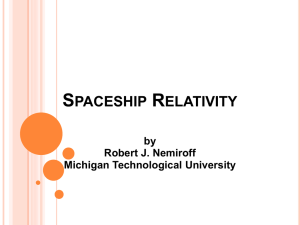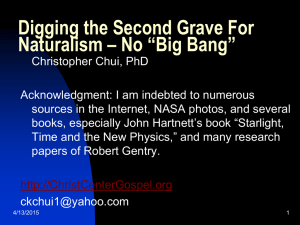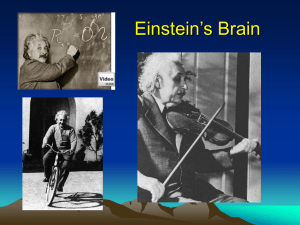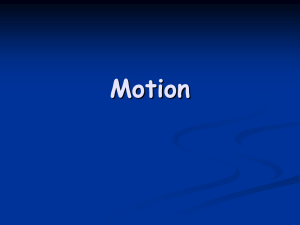chapterS2SpaceTime
advertisement
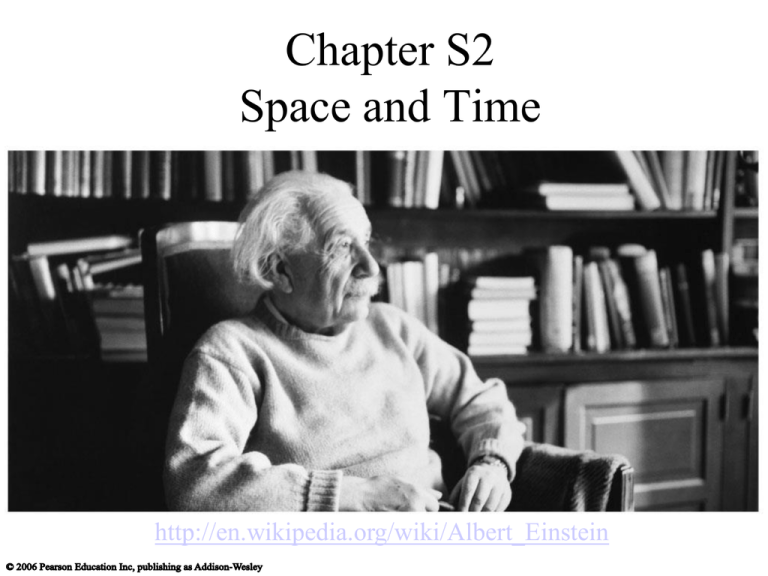
Chapter S2 Space and Time http://en.wikipedia.org/wiki/Albert_Einstein S2.1 Einstein’s Revolution • Our goals for learning • What are the major ideas of special relativity? • What is “relative” about relativity? What are the major ideas of special relativity? Einstein’s Theories of Relativity • Special Theory of Relativity (1905) – Usual notions of space and time must be revised for speeds approaching light speed (c) – E = mc2 • General Theory of Relativity (1915) – Expands the ideas of special theory to include a surprising new view of gravity Key Ideas of Special Relativity • No material object can travel faster than light • If you observe something moving near light speed: – Its time slows down – Its length contracts in direction of motion – Its mass increases, or its momentum no longer increases linearly with velocity for sure! • Whether or not two events are simultaneous depends on your perspective What’s relative about relativity? Relativity of Motion • Motion is not absolute—we must measure speed of one object relative to another • Example: Plane moving at 1,670 km/hr from E to W would appear from space to be standing still Absolutes of Relativity 1. The laws of nature are the same for everyone 2. The speed of light is the same for everyone All of relativity follows from these two ideas! Making Sense of Relativity • As children, we revised our ideas of “up” and “down” when we learned that Earth is round • Relativity forces us to revise how we think of “space” and “time” What have we learned? • What are the major ideas of special relativity? – No material object can exceed the speed of light – We must revise our notions of space and time when dealing with objects near light speed • What is “relative” about relativity? – All motion is relative – But laws of nature, including the speed of light, are the same for everybody S2.2 Relative Motion • Our goals for learning • How did Einstein think about motion? • What’s surprising about the absoluteness of the speed of light • Why can’t we reach the speed of light? How did Einstein think about motion? Reference Frames Ball moves at 10 km/hr in reference frame of plane Ball moves at 910 km/hr in reference frame of someone on ground • Motion can be defined with respect to a particular frame of reference Absoluteness of Light Speed Light moves at exactly speed c Light moves at exactly speed c (not c + 900 km/hr) • Einstein claimed that light should move at exactly c in all reference frames (now experimentally verified) What’s surprising about the absoluteness of the speed of light? Light moves at exactly speed c Light moves at exactly speed c (not c + 900 km/hr) Thought Experiments • Einstein explored the consequences of the absoluteness of light speed using “thought experiments” • The consequences will be easiest for us to visualize with thought experiments involving spaceships in freely floating reference frames (no gravity or acceleration) Relativity of Motion at Low Speeds Relativity of Motion at Low Speeds Relativity of Motion at High Speeds Light Speed is Absolute c + 0.9c = c !?! Relativity of Motion Why can’t we reach the speed of light? Trying to Catch up to Light • Suppose you tried to catch up to your own headlight beams • You’d always see them moving away at speed c • Anyone else would also see the light moving ahead of you Special Topic: What if Light Can’t Catch You • Is there a loophole? • What if you’re somehow moving away from a distant planet faster than the speed of light? • In that case you have no way of detecting that the planet is there. • Although there are some phenomena that move faster than light, no information can be communicated faster than the speed of light What have we learned? • How did Einstein think about motion? – Motion must be defined with respect to a reference frame • What’s surprising about the absoluteness of the speed of light – Velocities in different reference frames do not add up like we expect them to because the speed of light must be the same for everyone • Why can’t we reach the speed of light? – No matter how fast we go, light will always appear to move away from us at speed c S2.3 The Reality of Space and Time • Our goals for learning • How does relativity affect our view of time and space? • Do the effects predicted by relativity really occur? How does relativity affect our view of time and space? Path of Ball in a Stationary Train • Thinking about the motion of a ball on a train will prepare us for the next thought experiment Path of Ball in a Moving Train • Someone outside the train would see the ball travel a longer path in one up-down cycle • The faster the train is moving, the longer that path would be Time Dilation • We can perform a thought experiment with a light beam replacing the ball • The light beam, moving at c, travels a longer path in a moving object • Time must be passing more slowly there The Time Dilation Formula Light path in your reference frame c t v t c t 2 Light path in frame of other spaceship 2 2 2 2 v 2 t t 2 t c 2 2 v 2 t t 1 2 c 2 2 The Time Dilation Formula • Time will appear to pass more slowly in a moving object by an amount depending on its speed • Time almost halts for objects nearing the speed of light Simultaneous Events? • In your reference frame, red and green lights on other spaceship appear to flash simultaneously Simultaneous Events? • But someone on the other spaceship sees the green light flash first—simultaneity is relative! Length Contraction • Similar thought experiments tell us that an object’s length becomes shorter in its direction of motion Mass Increase • A force applied to a rapidly moving object produces less acceleration than if the object were motionless • This effect can be attributed to a mass increase in the moving object, or a momentum increase with velocity that is no longer linear, i.e. p=mv where =1/√1-(v/c)2 . Velocity Addition Velocit yof first ship in your frame v1 Velocit yof second ship in frameof 1st v2 Velocit yof secondship in your frame: v1 v2 v1 v2 1 c c Formulas of Special Relativity T ime Dilation: v 2 t t 1 2 c Length Cont raction : Momentum: v 2 l l 1 2 c mv p v 2 1 2 c Deriving E = 2 mc 1 v 2 m0 m m01 2 2 v 2 c 1 2 c for smallv 1 T otal energy= m c m0c m0v 2 2 2 Mass-Energy of object at rest 2 Kinetic Energy Do the effects predicted by relativity really occur? Tests of Relativity • First evidence for absoluteness of speed of light came from the Michaelson-Morley Experiment performed in 1887, the year Albert Einstein turned 8 years old. • Time dilation happens routinely to subatomic particles the approach the speed of light in accelerators • Time dilation has also been verified through precision measurements in airplanes moving at much slower speeds Tests of Special Relativity • Prediction that E=mc2 is verified daily in nuclear reactors and in the core of the Sun and every bright star in the sky. Kind of important in astronomy huh! Test Relativity for Yourself • If speed of light were not absolute, binary stars would not look like two distinct points of light • You can verify relativity by simply looking through a telescope at a binary star system A Paradox of Non-Relativistic Thinking • If speed of light were not absolute, you would see the car coming toward you reach the collision point before the car it struck • No paradox if light speed is same for everyone What have we learned? • How does relativity affect our view of time and space? – Time slows down for moving objects – Lengths shorten for moving objects – Relativistic Mass of a moving object increases – Momentum no longer increases linearly with speed – Simultaneity of events depends on your perspective • Do the effects predicted by relativity really occur? – Relativity has been confirmed by many different experiments S2.4 Toward a New Common Sense • Our goals for learning • How can we make sense of relativity? • How does special relativity offer us a ticket to the stars? How can we make sense of relativity? Making Sense of Relativity • According to you, time slows down in a moving spaceship • According to someone on that spaceship, your time slows down • Who is right? • You both are, because time is not absolute but depends on your perspective Toward a New Common Sense • As children we learned that “up” and “down” are relative • Relativity tells us that “time” and “space” are relative How does relativity offer us a ticket to the stars? A Journey to Vega • The distance to Vega is about 25 light-years • But if you could travel to Vega at 0.999c, the round trip would seem to take only two years! Some Corrections • This does not include the acceleration time of at least 1 year to get near the speed of light. This has to be done to get to Vega and back to earth, 4 times so you are not turned into goo by infinite accelerations. So actually it would take 6 years not two years with 4 years acceleration time and 2 years travel time. The acceleration of gravity of the earth, which you can tolerate, is g=9.8m/s2 =32ft/s2 =1LY/yr2 (yr=year; LY=Light Year). A Journey to Vega • At that speed, the distance to Vega contracts to only 1 light-year in your reference frame • Going even faster would make the trip seem even shorter! • But if you do not want to be turned to goo you had better take 4 year accelerating and deacclerating so you will not exceed Earth’s gravitational acceleration. A Journey to Vega • However, your twin on Earth would have aged 50 years while you aged only 2. Actrually 54 years on earth and 6 years for the traveler to Earth to Vega and then from Vega to Earth. • Time and space are relative! What have we learned? • How can we make sense of relativity? – We need abandon our old notions of space and time as absolute and adopt new a new common sense in which time and space depend on your perspective • How does special relativity offer us a ticket to the stars? – For someone moving near light speed, distances appear to become shorter because of length contraction Special Relativity Resources • Wikipedia Special Relativity Introduction to Special Relativity Special Relativity not an introduction

